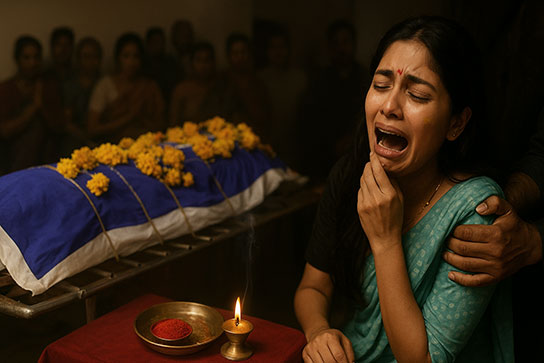The luxury fashion house, Prada recently unveiled a new collection of open-toe slip-on style sandals that are commonly known as Kolhapuri chappals in the local Indian market. But what is making jaws drop is the sky-high retail price of the Kolhapuri flats which is approximately Rs 1.2 lakhs per pair.
The high fashion footwear is crafted with premium materials and a minimalist Indian inspired design, that has sparked style and price tage related debates in the fashion circuit. Some hold the point of view that the new Prada Kolhapuris are a statement of luxury lifestyle and branding, while others question the logic of shelling out the whopping sum of money on a pair of every footwear.
The Italian luxury label unveiled its spring/summer 2026 collection in a dramatic showcase put together by Miuccia Prada and Raf Simons. With a total of 56 looks, the couture show featured contrasts including brown leather jackets and briefs, grey suits and red turtlenecks, chino trousers and handcrafted Kolhapuris. The theme of the coveted showcase was, "A shift of attitude - dismantling of meaning, and dismantling power."
But this introduction of Kolhapuris as couture footwear pieces had Indians with zooming in on four models wearing footwear that were most definitely Kolhapuri chappals that came with a luxe price tag of Rs 1.2 lakhs or 1000 euros.
Internet reacts
Celebrity stylist Anaita Shroff Adajania called out the Luxury brand as she shared a photo from the Prada show on Instagram and pointed out what was on everyone’s mind- these weren't just any designer sandals; they were "a pair of good old Kolhapuri chappals."
Diet Sabya, meanwhile, shared a long post on how the West was now borrowing from Indian craftsmanship and giving it a label and putting an exorbitant price tag on it.
“All that embroidery, all that artisanal flex, all produced in India. Always has been,” they added.
The internet, too, did not hold back as they called out Prada for stealing an idea and not giving due credit.
"How easily brands take away the OG identity and think it’s ok to do that… Guts" wrote a user while another hilariously pointed out, "Sarojini went international."
Another user expressed, "What's new? Take something from us and rebrand them and call it avant garde. I see exploitation."
One wrote, “These joggers are at every street vendor in Delhi’s Lajpat, Sarojini, Karol Bagh, etc. markets for Rs150-300.”
A user wrote, “Grandpa used to have the same chappal."
Another said, “THE CHAPPAL GOES GLOBAL."
“Let me dust off my Chappals and take them for a spin now!" someone else jokingly wrote.
A person dropped, “They love Indian culture and fashion but won’t say they’re inspired by everything Indian."
While fashion always reinvents, Prada’s new design seems to be slightly tone deaf without the label giving appropriate credit to Indian craftsmen.Hello @Prada
— SunandaSSinha (@SunandaSSinha) June 24, 2025
Your Spring Summer 2026 Men’s collection dropped #Kolhapuri-esque footwear - without giving any credit to the original & traditional craftsmanship of #Maharashtra (which has got GI tag also in 2019).
The concept & design that you have stolen, was originated in 12th… pic.twitter.com/z4QtX5Yeub
The origins
The Kolhapuri Chappal is a traditional craft practised by cobblers of Maharashtra and Karnataka. They date back to the 12th century, during King Bijjal’s rule in Bidar (Karnataka). His Prime Minister, Vishwaguru Basavanna, aimed to build a casteless society and uplift the cobbler community, which then embraced the Lingayat faith and began crafting durable, dignified footwear.
The 'Kolhapuri' brand emerged only in the early 20th century, when the footwear started being traded in Kolhapur, Maharashtra. Chhatrapati Shahu Maharaj later promoted its production and set up 29 tanning centres in the region.
In 2019, the Controller General of Patents, Designs and Trade Marks (CGPDTM) granted the Geographical Indication (GI) tag to Kolhapuri Chappal, recognising their origin in eight districts: Kolhapur, Sangli, Solapur and Satara in Maharashtra, and Belgaum, Dharwad, Bagalkot and Bijapur in Karnataka.
What also sets Kolhapuri Chappals apart is that they are handmade, crafted using vegetable-tanned leather and traditional techniques and tools. The process is extremely meticulous and it takes many people as well as several days for a Kolhapuri Chappal to be made.
If they are not handmade with leather, they are not real Kolhapuris.
From kings to the common man, Kolhapuris have been the footwear of choice beneath everyone's feet alike. The Beatles wore them too. So did many politicians. Celebrities continue to obsess over these. They are comfortable, versatile and sturdy. From heavy wedding finery to kurta-jeans combo for college, Kolhapuris go with it all.
“In a world chasing the next big trend, few designs have stood the test of time quite like the Kolhapuri Chappal with its origin tracing back to the early 13th century crafted by the Chamar community in Maharashtra. Made to endure long hours in the sun, heat, and terrain, they were functional, sturdy and resilient, much like the communities that wore them,” says Aprajita Toor, founder of eponymous footwear label.
She collaborates with artisans across Kolhapur and surrounding regions for her brands' offerings.
For many, Kolhapuris are not just footwear but a part of their personality. Skirt, mini skirt, skinny jeans, baggy denims, salwar kameez, a flared dress, tailored culottes, linen pants -- there is nothing a Kolhapuri looks off with.
The brand did not reference Kolhapuri’s Indian origin in their show note. The footwear was simply called leather sandals. However, it still stands a chance to give the credit where it is due. All eyes on when Prada lists the new collection pieces on their website.
“If we say they've introduced it to the world, then yes, it's global recognition. Kolhapuris now reach the world stage, fashion weeks and luxury stores. But it also feels like cultural appropriation dressed up as luxury. If Prada collaborates with local craftsmanship, acknowledges the roots and uplifts those people, it can be a plus. Due credit should be given so it’s recognised as tradition, as a cultural step,” says Sukrit Khanna, founder of footwear brand Artimen.





